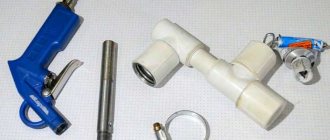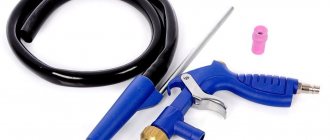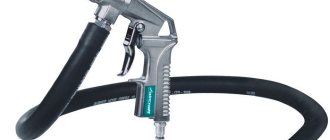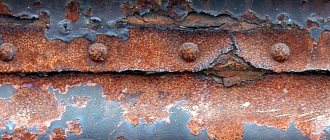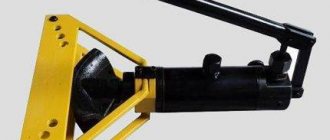- Lever.
- Trigger.
- Nozzle for spraying air-sand mixture.
- Bushing for connecting a tank or sand supply hose.
- Sand reservoir.
- Bushing for connecting the air supply hose from the compressor.
In many ways, a sandblasting gun resembles a spray gun, only the nozzle here is made of a different material and has a different diameter. The principle of its operation is as follows: compressed air from the compressor is supplied through the hose through the bushing ( 6 ). At this time, abrasive is sucked out of the reservoir ( 5 ), which is supplied to the nozzle ( 3 ) of the gun. And the abrasive is blown out of the nozzle under pressure onto the material being processed. Essentially, the gun has an injection method of operation, in which air and sand are supplied through different hoses. Because of this, the performance of conventional pistols is several times less than that of sandblasting machines, and they are much weaker than their larger-sized counterparts.
TOP 13 best sandblasting guns
| Photo | Name | Rating | Price | |||
| The best sandblasting guns with tank feed | ||||||
| #1 | Sandblasting gun Sorokin 10.15 | ⭐ 5 / 5 4 - votes | Find out the price | |||
| #2 | Sandblasting gun with tank NEO 12-560 | ⭐ 4.95 / 5 2 - votes | Find out the price | |||
| #3 | Gun ROCKFORCE RF-2376 | ⭐ 4.9 / 5 1 - voice | Find out the price | |||
| #4 | Sandblasting gun KRAFTOOL “EXPERT QUALITAT” 06583 with lower tank 1000 ml 5 atm | ⭐ 4.85 / 5 1 - voice | Find out the price | |||
| #5 | Sandblasting gun Sturm AU-1720-03 | ⭐ 4.8 / 5 1 - voice | Find out the price | |||
| #6 | Sandblasting gun CONCORDE SBG1000Q with tank 6619251 | ⭐ 4.75 / 5 2 - votes | Find out the price | |||
| Best Hose Feed Sandblasting Guns | ||||||
| #1 | Sandblasting gun MIGHTY SEVEN SX-3103 | ⭐ 5 / 5 2 - votes | Find out the price | |||
| #2 | Sandblasting gun for cameras AE&T T063P | ⭐ 4.95 / 5 | Find out the price | |||
| #3 | Sandblasting gun with hose NEO 12-558 | ⭐ 4.9 / 5 | Find out the price | |||
| #4 | Sandblasting gun with hose PS-1 Zitrek 015-1340 | ⭐ 4.85 / 5 1 - voice | Find out the price | |||
| #5 | Air gun FUBAG SBG142/3 110116 | ⭐ 4.8 / 5 1 - voice | Find out the price | |||
| #6 | Gun MATRIX 57328 | ⭐ 4.75 / 5 | Find out the price | |||
| #7 | Pistol PATRIOT GH 166B 830902021 | ⭐ 4.7 / 5 1 - voice | Find out the price | |||
Which sandblasting gun would you choose or recommend?
Take the survey
Sandblasting installations of ejector and pressure type: features and differences
According to the principle of abrasive blasting, sandblasting machines are divided into ejector (injection) and pressure. Let's consider the main features, advantages and disadvantages of these systems.
Ejector installations:
Such devices are characterized by low compressed air consumption, lower productivity and lower abrasive pressure at the outlet of the nozzle, in comparison with pressure units.
This type of device is used for delicate cleaning of surfaces made of soft materials (such as copper and aluminum), as well as on surfaces without heavy contamination.
The ejector apparatus consists of an ejector gun, an abrasive container and a set of connecting hoses.
The principle of ejector or injection material transfer is based on the creation of reduced pressure in the mixing chamber following the air nozzle in front of the abrasive blasting nozzle. Due to the reduced pressure, a vacuum is created in the mixing chamber itself and further along the entire line of the suction abrasive hose, thereby entraining abrasive particles from the receiving hopper or container with abrasive.
In this case, part of the energy of the transmitted pressure of the air stream from the air nozzle is lost on the absorption of dosed abrasive particles, while the main flow accelerates the incoming abrasive particles in the sandblasting nozzle at the outlet of the ejector gun. Abrasive blasting nozzles can be used with a straight cylindrical shape, but for a greater “acceleration effect” nozzles with a Venturi channel can be used.
The ejector gun consists of an air nozzle, an abrasive blast nozzle, a gun body consisting of a mixing chamber and connecting elements for connecting the air hose and the suction abrasive hose. An ejector gun is characterized by lower outlet pressure, unlike pressure guns.
General structure of an abrasive blasting ejector gun
- Abrasive blasting nozzle (4-12 mm);
- Union nut;
- Pistol body;
- Fitting for fastening the abrasive material supply hose;
- Air nozzle (2-6mm, selected in accordance with the abrasive nozzle);
- Fixing bolt;
- Air supply control valve (the camera gun does not have one).
TABLE OF COMPARATIVE FEATURES OF EJECTOR AND PRESSURE UNITS
| Pressure sandblasting unit (tank, barrel) | Ejector (injection) sandblasting unit Blasting according to the Venturi principle | |
| The principle of feeding material into the sleeve and nozzle: | Pressure principle : air and abrasive material are supplied under pressure through one hose. | Suction principle: air and abrasive material are fed through different hoses into a nozzle holder consisting of 2 nozzles (air and abrasive). At the beginning of the air supply along the hose, at the moment of vacuum between the nozzles, the suction of the air-abrasive mixture begins. |
| Principle of operation | From a closed container, the abrasive material under pressure passes through a dosing device, fed into the mixing tee, where it is evenly distributed in a stream of compressed air and enters the sandblasting hose and through the Venturi sandblasting nozzle, sprayed at speed onto the parts to be cleaned. | Compressed air under pressure enters the expansion chamber of the gun. The air nozzle, as a rule, is 2-3 times smaller than the sandblasting one, and due to the difference in the diameters of the nozzles, a vacuum is formed in the chamber. Due to the rarefaction of the air, the abrasive is sucked into the chamber through the supply hose, passes through the abrasive blasting nozzle together with a stream of air, and is then sprayed onto the surface to be treated. |
| External differences: | A single volumetric hose through which the abrasive along with air is supplied from the mixer to the nozzle | The device is equipped with two hoses - air and abrasive. |
| Speed and pressure indicators: | A pressure-type device has significantly more power than an injection unit. | The speed, energy and pressure of abrasive supply are much lower than in a pressure-type apparatus. The pressure on the air nozzle is higher than on the abrasive nozzle. |
| Scope of application | Large-scale cleaning work during construction or in inhabited chambers in industry. Large surfaces. Deep cleaning of metal, concrete or alloy structures (bridges, building structures, facades, railway cars) | Easy to medium cleaning, removal of paint defects. Delicate (soft) processing of small surfaces. Small volumes of work, processing of thin sheets of metal or wood, automotive and aircraft parts. |
| Usage | Treatment of massive contaminants, removal of deep rust, old paintwork. | Processing of soft metals (aluminum, copper). Deburring, light shot blasting and descaling without penetrating metal, applying patterns, matting glass or mirrors. |
| Average performance | from 5 to 40 m2/hour, 30-40 m/s. | from 0 to 5 m2/hour, which is almost 7 times less than that of a pressure sandblasting unit. |
| Peculiarities | It is imperative to have a sealed container for the abrasive, due to the effect of high pressure on the abrasive. | The abrasive is supplied under less pressure, the processing volume is reduced, and it can be processed with an ejector gun without an abrasive container (sampling from a heap). |
| ISO processing degree | High degree of SA | Low SA (max SA 1) |
| Mobility | They are divided into mobile and stationary. | Mobile. |
| Advantages | Fast processing. Possibility of processing large surfaces. Cleaning of coarse, treatment-resistant stains. | Low price of equipment and cost of work. Easy to install and transport. Minimum air consumption, convenient to use when air supply or access to the product is limited. Soft delicate cleaning. |
| Flaws | Heavy weight Consumes a lot of air and abrasive material. | Poor performance. Will not cope with significant scale. |
Table 1. Required volume of compressed air (ejector units)
| Nozzle Ø (mm) | Ø abrasive jet nozzle (mm) | REQUIRED AIR VOLUME (m³/min.) at operating pressure, bar | ||||||||
| 2 | 3 | 4 | 5 | 6 | 7 | 8 | 10 | 12 | ||
| 3,2 | 6,0 | 0,245 | 0,326 | 0,406 | 0,487 | 0,568 | 0,649 | 0,730 | 0,891 | 1,050 |
| 4,0 | 8,0 | 0,436 | 0,579 | 0,723 | 0,865 | 1,010 | 1,150 | 1,300 | 1,585 | 1,870 |
| 5,0 | 10,0 | 0,681 | 0,905 | 1,130 | 1,350 | 1,580 | 1,800 | 2,030 | 2,480 | 2,930 |
Table 2. Air consumption (pressure units)
| Nozzle diameter, mm | Min. consumed air volume, m3/min | 50% reserve (pressure backup) | Required air volume | Average productivity in m2/h | Average abrasive consumption in kg/m2 | ||||
| SA2 | SA2 1/2 | SA3 | SA2 | SA2 1/2 | SA3 | ||||
| 3.5 | 0.7 | 0.4 | 1.1 | 1.5 | 0.9 | 0.5 | 50 | 75 | 92 |
| 5.0 | 1.4 | 0.6 | 2.0 | 4 | 2 | 1.2 | 45 | 69 | 84 |
| 6.5 | 2.3 | 1.4 | 3.7 | 10 | 5 | 4 | 40 | 58 | 78 |
| 8.0 | 3.9 | 2.2 | 6.1 | 15 | 9 | 6 | 35 | 51 | 68 |
| 9.5 | 5.5 | 3.0 | 8.5 | 21 | 14 | 9 | 32 | 46 | 62 |
| 11.0 | 7.2 | 3.9 | 11.1 | 28 | 21 | 13 | 29 | 42 | 56 |
| 12.5 | 9.6 | 5.0 | 14.6 | 37 | 28 | 17 | 28 | 40 | 54 |
How to choose the right sandblasting gun
When going to buy a pistol at a hardware store or opening an online store, you should ask yourself: what to do next with this device? How much work is there to cope with? The key word here is pressure level. For garage work “from time to time,” models with a pressure of 3-6 atmospheres are usually purchased. The flexibility of the hose, the power of the compressor, and the permeability of the nozzle also matter. It's good if the kit includes a spare one. Most inexpensive models (up to 1000 rubles) suffer from the fact that they can only use fine-grained sand; coarser sand will get stuck. If you need a durable model that works without flaws, you should set yourself to a price of 2000 - 3000 rubles.
Video - Which closed type sandblasting gun is better?
Advantages and disadvantages
Sandblasting equipment allows you to process almost any material. The result of removing plaque, rust and other contaminants is one hundred percent. The shape of the abrasive particles makes the surface rough, making the product easy to paint in the future. The choice of cleaning method allows you to adapt the equipment to any requirements. The degree of work is divided into five categories, from minor cleaning to coarse element removal.
Due to their widespread use, sandblasting machines are popular both in production and in home life. A simple way is to buy a finished product, but this will require serious expenses and may not be worth the cost if used rarely. For one-time events, it is possible to purchase a unit for rent, however, with prolonged use, the rental may exhaust financial resources.
It is possible to make sandblasting equipment yourself; it is enough to have welding skills and read drawings. Manufacturing diagrams are available on the Internet, there are videos and instructions.
It should be understood that handling sandblasting equipment can be harmful to human health. It is necessary to fully comply with safety requirements, use a respirator and a protective suit. Also considered a disadvantage is the massive design, high material consumption for large production volumes.
Advice from experts on working with sandblasting
As is already clear, sandblasting guns are characterized by their simplicity of design. Many people think that working with these devices is just as easy - press a button and clean it. This is not an industrial sandblasting installation, where you need to undergo instructions, check all the equipment and put on a protective suit. But there are rules here too:
- If possible, you should work indoors - in the process, abrasives harmful to the environment will fly away. Only when cleaning rust, for example, from a gate, can you work outdoors;
- the floor before work is lined with oilcloth;
- all foreign objects are removed. If flying abrasive hits any object during operation, the item will be irrevocably damaged.
The garage where the work is being done should be well lit and free of clutter.
Experts advise giving preference to well-known brands - such as Mighty Seven, Neo, Makita. Among the domestic ones, Sorokin, which is not so famous, but is not inferior in quality, successfully competes with them.
Industry sectors
Several industrial methods are used to operate a sandblasting machine. The most common type of sandblasting activity is cleaning materials under high pressure. This type of work has proven itself to be cheap and reliable in all areas of industry.
Cleaning using injection-type sandblasting is used for small jobs. The main features are low air and energy consumption, which allows you to save on energy bills. The use of wet abrasive involves cleaning structures made of stainless materials. This method allows you to quickly and efficiently clean the surface.
Making from a spray gun
Sandblasting can also be done using a spray gun. The following components should be prepared:
- gun with mixing valve;
- handle with air supply device;
- a plastic bottle that will act as a container for abrasive;
- tee;
- a ball valve with which you can control the supply of sand.
The assembly of such a device will be carried out according to the following algorithm:
- the gun should be bored out so that the diameter of the inlet nozzle increases;
- the mixing tee should be connected to the gun;
- Next, it is necessary to install and secure the supply and circulation hoses;
- Now you need to press the trigger so that the abrasive is released. If everything works fine, then the device from the painting console is ready for use.
It should be added that a small plastic container will be enough to clean surfaces within half an hour.
Assembling the apparatus from a gas cylinder
The next option for creating such a device is from a gas cylinder. You will need to have:
- gas cylinder;
- ball valves – 2 pcs.;
- a piece of pipe that will become the basis of a funnel for filling the container with sand;
- brake tees – 2 pcs.;
- hoses with a nominal bore of 10 and 14 mm - they are needed to connect to the compressor and remove the mixture;
- clamps for securing the sleeves;
- fum tape.
The algorithm of actions will be as follows.
- Preparing the balloon. You will need to remove the remaining gas from it and clean the inside of the surface using non-abrasive detergents and wait until the surface is dry.
- Making holes in the container. The hole at the top will be used to pour sand. It should be the same size as the prepared pipe. The hole at the bottom is for the compressor, or more precisely, for connecting a tap.
- Crane installation. It can be welded or simply screwed using an adapter pipe.
- Now all that remains is to mount the brake tee and the mixer block. To make the threaded connection as tight as possible, you can use fum tape.
- A tap is mounted on the balloon valve, after which a tee is located.
- Next, you need to decide to make the device as mobile as possible. To do this, you can weld the handles and wheels for ease of transportation. To make the device stable, you need to weld supports from a corner or parts of reinforcement.
It remains to connect the parts of the supply and delivery channels of the composition:
- the fittings must be mounted on the tee and the balloon valve;
- a sleeve with a 14mm passage should be placed between the tee and the mixer area;
- a pressure-type installation should be connected to the tee branch, which is free and equipped with a fitting;
- a hose for supplying the finished composition is connected to the last free outlet from the tee.
To create a tight structure, a screw-type cap can be mounted on the pipe for filling the cylinder with sand.
Preparing tools
To obtain sandblasting, you will need to have the following components on hand:
- nozzle;
- compressor;
- a gas cylinder that will act as a container for abrasive.
In addition, depending on the characteristics of the structural type, the following elements may be needed:
- Ball Valves;
- rubber hose equipped with reinforced inserts 1.4 cm or more;
- air hose with a diameter of up to 1 cm;
- transition type coupling;
- fittings, which are hose fastenings or collet-type clamps;
- fum tape, which allows you to seal connections;
- glue gun or an analogue for polyurethane foam;
- hot glue;
- empty 0.5 liter plastic bottle;
- grinder or file;
- sandpaper with a block;
- drill with drills;
- Bulgarian;
- sharp knife;
- pliers.
